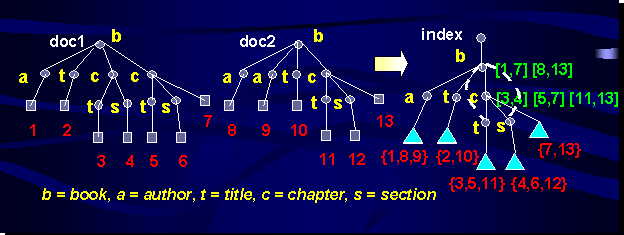NoSQL databases
-
non relational databases, flexible schema
-
often used for big data applications, clusters
-
different storage structure than SQL databases
-
give up constraints/transactions to improve performance
-
low-level interface
NoSQL types
-
key-value
-
Redis, Memcached, Amazon SimpleDB…
-
-
document (JSON, XML…)
-
CouchDB, Elasticsearch, MongoDB…
-
-
graph / RDF triple
-
Virtuoso, Neo4j…
-
-
object
-
Caché, GemStone…
-
RDF databases / triple store
-
standard data model (RDF)
-
standardized interchange format (N-Triples, N-Quads, XML,…)
-
query language (SPARQL), Linked Data
-
native
-
Apache Jena, Sesame/RDF4J…
-
-
RDF layer to relational database
-
Virtuoso, IBM DB2…
-
SPARQL
-
SPARQL Protocol and RDF Query Language
-
W3C Recommendation SPARQL 1.1, March 2013
-
SELECT - values as table
-
CONSTRUCT - extract RDF
-
ASK - true/false
-
DESCRIBE - extract RDF graph
-
inferencing
SPARQL example
- Ontology
ex1:FullProfessor rdf:subClassOf ex1:Professor.
ex1:AssistantProfessor rdf:subClassOf ex1:Professor.
ex1:Professor owl:equivalentClass ex2:Teacher- Data
ex1:Bob rdf:type ex1:FullProfessor .
ex1:Alice rdf:type ex1:AssistantProfessor .
ex2:Mary rdf:type ex2:TeacherSPARQL example
- Data
ex1:Bob rdf:type ex1:FullProfessor .
ex1:Alice rdf:type ex1:AssistantProfessor .
ex2:Mary rdf:type ex2:Teacher- SPARQL query
SELECT ?x
WHERE {
?x rdf:type ex1:Professor
}-
noone is Professor, but inferencing will find Bob, Alice, Mary
XML databases, when to use
-
working with documents or metadata in XML format
-
data format/schema changes over time
-
complex and variable schema
-
structure queries
XML database concepts
-
basic element = document
-
documents gathered in collections ("tables")
-
query on document structure
-
output is document, document fragment, or constructed XML
XML database types
-
XML-enabled databases
-
mapping XML data to own data model (relational, object…)
-
character large object
-
fragmented to series of tables/objects
-
stored in XML Type
-
-
ISO SQL/XML - element construction, data mapping, enhanced SQL with XQuery
-
Oracle, IBM DB2, MS SQL, PostgreSQL
-
XML database types
-
native XML databases
-
using XML data model directly
-
-
open-source
-
eXist, Sedna, BaseX, MonetDB, Oracle/Berkeley DB XML
-
-
commercial
-
MarkLogic, Virtuoso, Qizx
-
Interface
- XQuery
<titles>{
for $book in collection("books")/book where $book/year="1990"
return $book/title
}</titles>Interface
- XQuery Update
update delete collection("books")/book/isbnupdate insert <title>XQuery Guide</title>
into collection("books")/book[isbn="42"]Interface
- SQL/XML (result-table)
SELECT
id, vol,
xmlquery('$j/name', passing journal as "j") as name
FROM
journals
WHERE
xmlexists('$j[licence="CreativeCommons"]',
passing journal as "j")Interface
- SQL/XML (result-XML)
SELECT XMLELEMENT (NAME "saleProducts",
XMLNAMESPACES (DEFAULT 'http://posample.org'),
XMLAGG (XMLELEMENT (NAME "prod",
XMLATTRIBUTES (p.Pid AS "id"),
XMLFOREST (p.name AS "name",
i.quantity AS "numInStock"))))
FROM PRODUCT p, INVENTORY i
WHERE p.Pid = i.Pid-
XSLT - output transformation
-
XML Schema - input validation
Interface
-
XQJ - XQuery API for Java
-
unified query layer between application and XML Datasource
-
prepared statements
-
binding variables
-
Interface
XQDataSource xqs = new ExistXQDataSource();
XQDataSource xqs = new SednaXQDataSource();
xqs.setProperty("serverName", "localhost");
XQConnection conn = xqs.getConnection();
XQExpression xqe = conn.createExpression();
String xqueryString = "for $x in doc('books.xml')//book
return $x/title/text()";
XQResultSequence rs = xqe.executeQuery(xqueryString);
while(rs.next())
System.out.println(rs.getItemAsString(null));
conn.close();Interface
-
XML:DB
-
similar concept to JDBC, abstract interface to XML database
-
Driver - access to given database
-
Collection - document collection in database
-
Services - support database features, e.g. XPathQueryService, XUpdateQueryService
-
Resource - data stored in database
-
ResourceSet - data as result of query
-
Storage
-
intact document storage
-
unique identifier for document
-
preferably parse and index on storage
-
on query: fast, if application need access to whole document and index can select the right document
-
slow, if additional parsing needed
-
Storage
-
parsing documents
-
document parsed on save and stored in own data model (eg. DOM)
-
addressable numbered nodes - some operations faster based on numbers
-
no need for parsing on query, more efficient
-
retrieved document not 100% same
-
fine granularity for addressing
-
partial modifications
-
Indexing
-
index scope - collection, database, document
-
index target - document, node
-
value index
-
store all combinations of element/attribute values
-
-
substring index
-
for contains() etc., store n-grams
-
Indexing
-
structural index
-
track existing paths, enriched tree, trie, DataGuide etc.
-

Benchmark
-
compare database performance
-
mostly XQuery speed, less often Update
-
data generator (up to GBs) and a set of XQueries
-
XMark, XBench, XMach-1
-
TPoX - complex database testing, XQuery and SQL/XML, indexing, XML Schema, XQuery Update